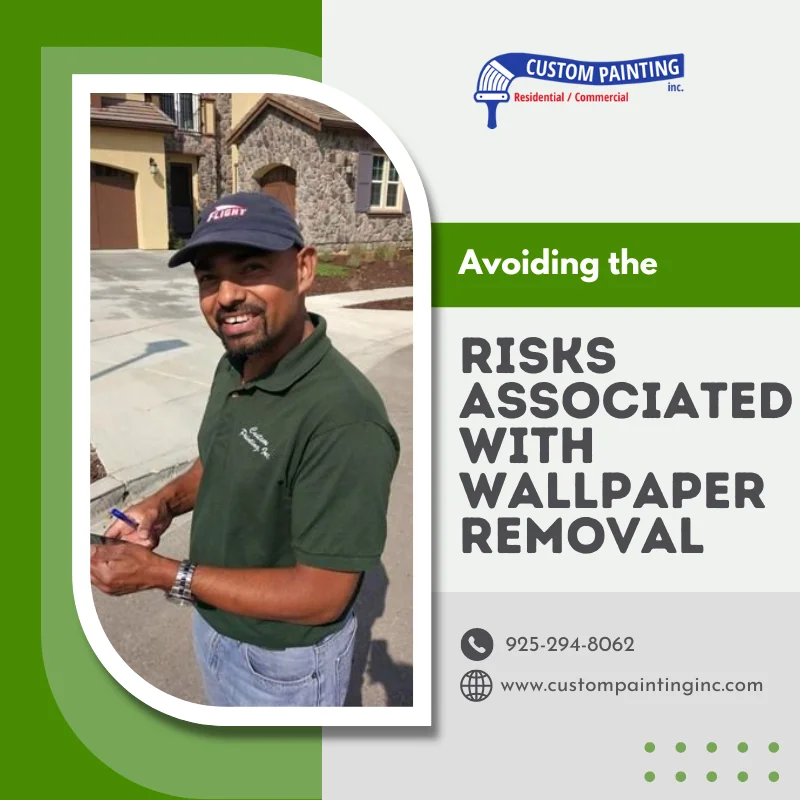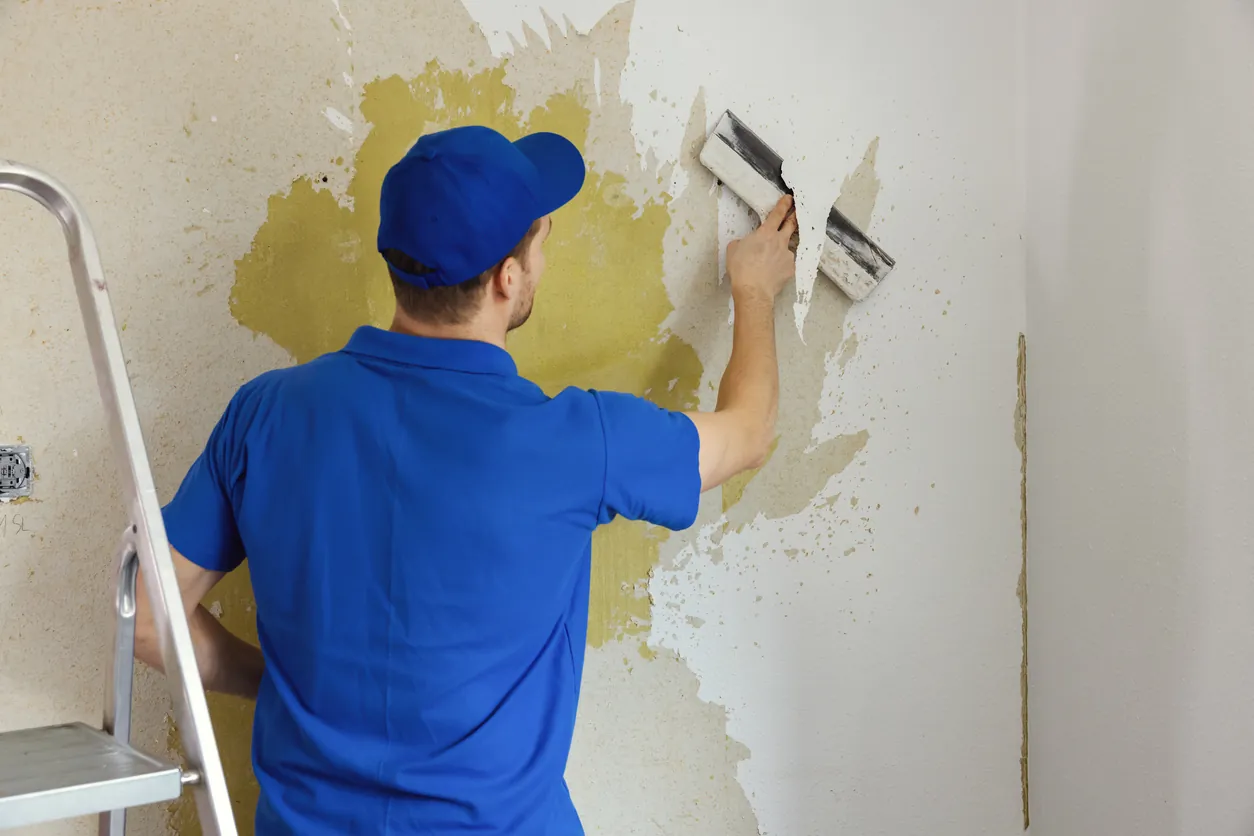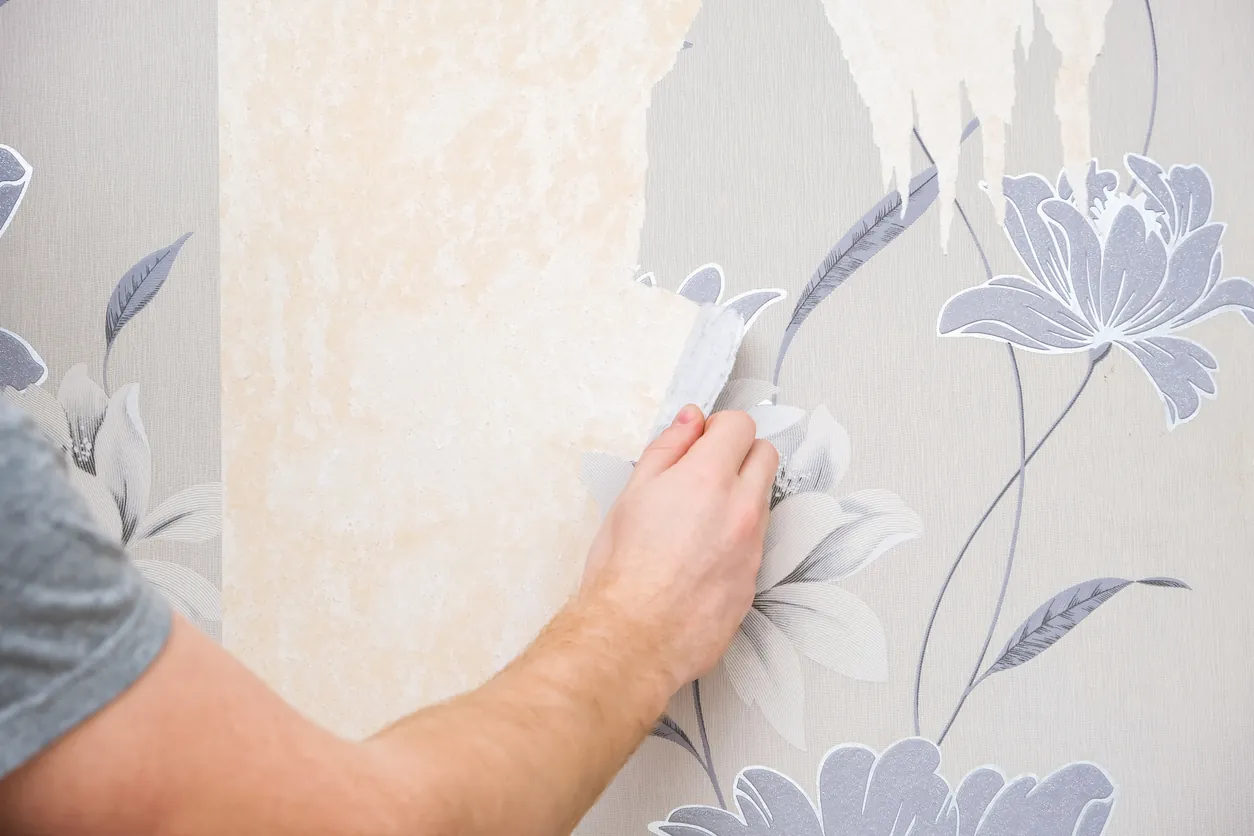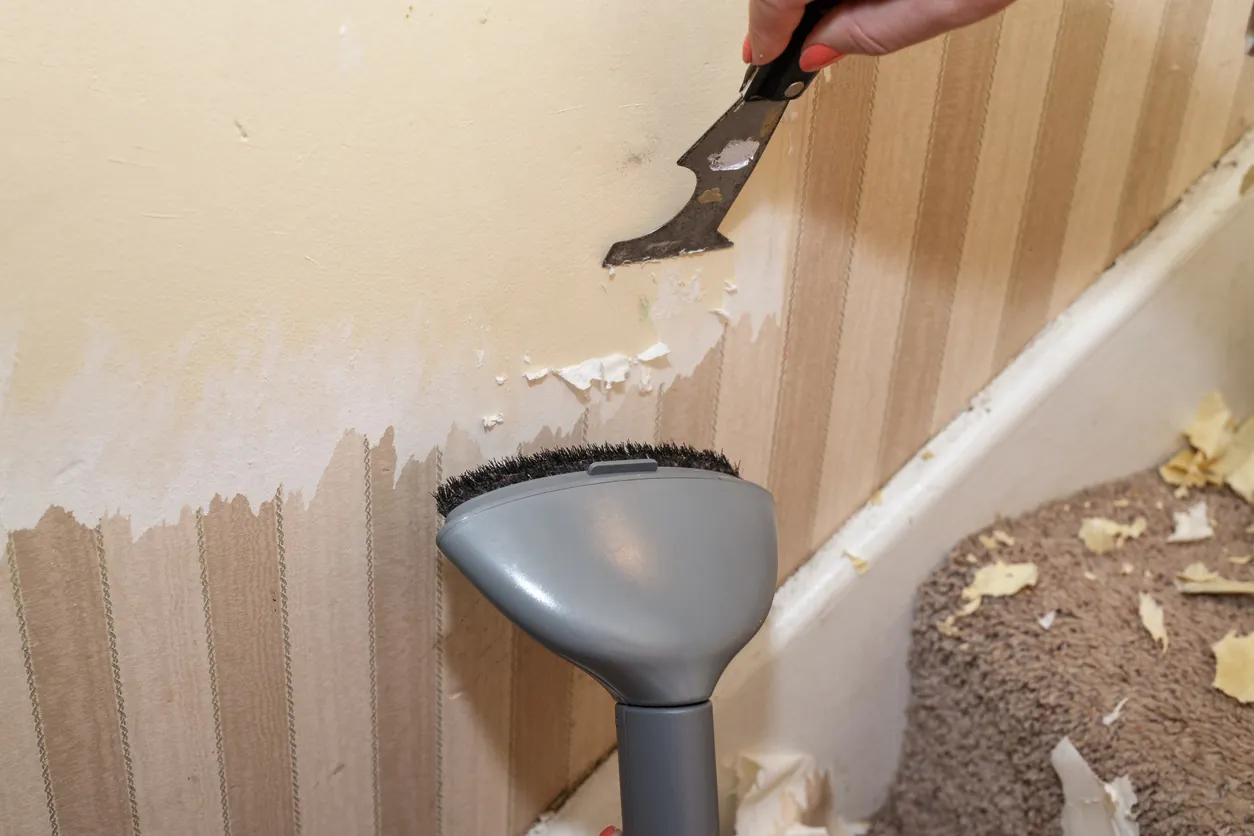For most DIY home improvement enthusiasts, wallpaper seems a simple project that they wouldn’t have second thoughts about attempting it.
While DIY wallpaper removal may seem tempting, it carries significant risks, such as damaging the walls, leaving behind adhesive residue, or causing issues that could require costly repairs. Hiring a professional painting company ensures the wallpaper is safely and effectively removed, preserving the integrity of your walls and saving you from potential headaches and expenses in the long run.
Common risks for DIY wallpaper removal
Many DIYers remove the wallpaper mainly to save time and money. However, many don’t seem to understand the following risks:
- Wall damage: Improper removal techniques, such as pulling too hard or not using the correct tools, can result in significant wall damage. It includes gouges, tears, and peeling of drywall or plaster, which can lead to costly repairs and require additional work to smooth the surface before repainting or re-wallpapering.
- Hidden mold and mildew: Removing wallpaper can expose hidden mold or mildew, particularly in older homes or humid environments where moisture gets trapped behind the wallpaper. It poses a risk to the wall’s structural integrity and presents serious health hazards, including allergies and respiratory issues.
- Residual adhesive: Leftover adhesive from the removed wallpaper can affect the finish of new paint or wallpaper if not thoroughly cleaned. It can lead to unsightly bumps, stains, or uneven surfaces, requiring additional time and effort to prepare the wall for new finishes.
- Structural issues: During the wallpaper removal process, underlying structural issues may be uncovered, such as cracks in plaster, loose drywall, or signs of water damage. These issues often require professional assessment and repair, potentially escalating the scope and cost of the project.
- Electric hazards: Another potential risk is the electrical wiring behind the walls. If the DIYers aren’t cautious, they may accidentally cut or penetrate an electrical component while removing wallpaper, which could result in an electrical shock, fire, or electrocution.
Before taking the DIY step, consider if DIY wallpaper removal is worth the risk or call a professional to do the work.
The importance of surface preparation
- Surface damage minimization: Professionals prioritize protecting walls during wallpaper removal by testing different methods to determine the best approach. It involves understanding the type of wallpaper (e.g., vinyl, fabric, or peelable) and the wall material (e.g., drywall, plaster). Using the appropriate removal technique—such as steaming, soaking, or chemical solutions—minimizes the risk of damaging the wall surface.
- Removing adhesive residue: Thorough removal of adhesive residue is crucial to achieving a smooth, paint-ready surface. The residue left behind can cause bumps and imperfections, affecting the quality of subsequent paint or wall coverings. Professionals use specialized tools and cleaning solutions to ensure the complete removal of the adhesive, creating a clean foundation for the next steps.
- Repairs before painting: Once wallpaper and adhesive are removed, walls may need patching or repairing, especially if the surface has minor dings, holes, or scratches. Professionals are skilled in identifying these issues and performing the necessary repairs—such as filling holes, sanding, and priming—to ensure a flawless finish when painting or applying new wall coverings.
Professional wallpaper removal techniques
- Steaming: Professionals often use wallpaper steamers to safely and effectively loosen wallpaper without damaging the walls. The steamer heats water to produce steam that penetrates the wallpaper and softens the adhesive beneath, making it easier to peel away. This method is ideal for older wallpapers or those with stubborn adhesives.
- Chemical solutions: Specialized, eco-friendly removal solutions are another popular choice for professionals. These solutions break down the wallpaper’s adhesive backing, making removal easier. They are formulated to be effective without harming the underlying surface or releasing harsh chemicals into the environment.
- Scoring tools: Professionals use scoring tools to perforate the wallpaper surface in a controlled manner. These tools create small holes that allow steam or chemical solutions to penetrate the adhesive layer deeply, ensuring thorough removal. They use these tools carefully to avoid damaging the wall beneath, making the removal process more efficient and complete.
Identifying wallpaper types and adhesion
When it comes to wallpaper removal, the type of wallpaper and the degree of adhesion play a crucial role in determining the appropriate technique for safe removal:
Types of wallpaper
- Vinyl wallpaper: Often used in high-moisture areas like kitchens and bathrooms, vinyl wallpaper has a plastic surface that makes it durable and washable. It usually has a paper or fabric backing. Vinyl wallpaper can sometimes be peeled off in sheets; however, the backing may remain on the wall and require soaking with water or a wallpaper removal solution for proper removal.
- Paper wallpaper: Traditional paper wallpapers can be more delicate and prone to tearing. Removing them involves soaking the paper thoroughly with water or a solution to loosen the adhesive. Steamers are also commonly used. Careful peeling is necessary to avoid tearing and damaging the wall underneath.
- Fabric-backed wallpaper: These wallpapers are durable and thicker, making them more resistant to tearing during removal. They often require more effort to strip away, sometimes necessitating using a steamer or specialized wallpaper removal tools.
Degree of adhesion
- Older wallpapers: Wallpapers that have been on the wall for a long time, or those applied with extra adhesive, can be particularly challenging to remove. The adhesive may have hardened over time, making it difficult to penetrate. Improper removal techniques, like aggressive scraping or pulling, can damage the wall, so scoring the wallpaper and using a steam or chemical solution to soften the glue are often necessary.
- Overly adhesive applications: Wallpapers applied with high-strength adhesives or multiple layers of glue can leave residue on the walls. Using a wallpaper removal solution or a combination of soaking and steaming is often needed to break down the adhesive for safe removal.
Multiple layers of wallpaper
- Professional removal techniques: In older homes, it’s common to find multiple layers of wallpaper applied over the years. Professionals often use a systematic approach, scoring the outer layers to allow water or steam to penetrate. They carefully remove each layer one at a time to avoid gouging or damaging the wall surface. This method helps ensure that the original wall remains intact while each layer of wallpaper is stripped away.
Using the correct removal technique based on the type of wallpaper and the degree of adhesion is crucial for avoiding damage to walls and ensuring a smooth finish for future treatments.
Health and safety considerations
When removing wallpaper, health and safety considerations are crucial:
- Lead paint concerns: In homes built before 1978, disturbing wallpaper may expose lead-based paint underneath, posing severe health risks. Professionals use lead test kits, wear protective gear, and follow EPA guidelines to minimize lead dust and safely contain it.
- Mold and mildew remediation: If mold or mildew is discovered behind wallpaper, professionals assess the extent of contamination and use protective equipment and containment strategies to prevent spores from spreading, ensuring safe removal and air quality.
- Proper ventilation: Adequate ventilation is essential, especially when using chemical solutions to remove wallpaper. It helps protect indoor air quality and prevents inhalation of harmful fumes, reducing the risk of respiratory issues.
Preparing the walls for painting after wallpaper removal
Preparing walls for painting after wallpaper removal involves several crucial steps to ensure a smooth, flawless finish:
1. Smoothing the surface
After wallpaper removal, walls may have residual adhesive, texture, or minor damage. Professionals carefully smooth the surface by:
- Removing residual adhesive: Scrape off any remaining wallpaper paste and clean the walls with a damp sponge and mild detergent to eliminate all residues.
- Sanding: Use sandpaper or a sanding block to smooth out rough areas, ensuring all old adhesive and textures are completely gone.
- Repairing damage: Filling in holes, dents, or cracks with a patching compound and sanding the repairs flush with the wall creates a seamless surface ready for priming and painting.
2. Priming the walls:
Priming is essential after wallpaper removal to ensure a quality paint job:
- Sealing the surface: A primer seals in leftover adhesive that might cause stains or paint bubbling, providing a uniform base.
- Improving paint adhesion: Priming enhances paint adhesion, especially on porous or newly repaired surfaces, preventing peeling and uneven finishes.
- Blocking stains: Special stain-blocking primers can prevent discoloration from old wallpaper adhesive from bleeding through the new paint.
3. Choosing the right paint:
Selecting the best paint type for newly bare walls depends on several factors:
- Wall material: Consider the wall material (drywall, plaster, etc.) and the repair work done. High-quality latex paint is often recommended for its durability and ease of application.
- Finish: Choose a finish that complements the room’s needs—matte or eggshell for a smooth, subtle look, or satin and semi-gloss for more durability and washability, especially in high-traffic areas.
- Coverage and durability: Choose a paint that offers good coverage and is durable enough to handle imperfections or wall repairs.
Proper preparation, priming, and paint selection are crucial steps to achieve a professional-looking paint job after wallpaper removal.
Why hiring a professional company is the best choice
- Experience and expertise: Hiring a professional company for wallpaper removal is the best choice because of their experience and expertise. Professional painters understand the complexities of wallpaper removal, including how to avoid damaging the underlying walls and ensure a clean, smooth surface.
- Tools and techniques: Professionals have access to specialized tools and techniques that make the process safer and more efficient, minimizing risks and reducing the time spent on the project.
- Handling surprises: Professionals are equipped to handle unexpected issues, such as mold, damaged drywall, or hidden structural problems, ensuring the project stays on track and is completed to a high standard.
Conclusion
Attempting to do DIY wallpaper removal can come with many risks: wall damage, adhesive residue, hidden health hazards, and electrical hazards. Any DIYer who does not practice caution when removing wallpaper may experience any of these risks.
Trusting professional painters for wallpaper removal ensures a safe, efficient process that properly prepares your walls for a fresh, high-quality finish. Contact Custom Painting, Inc. today at 925-294-8062 or message our contact page for a consultation and estimate on wallpaper removal and painting services!




